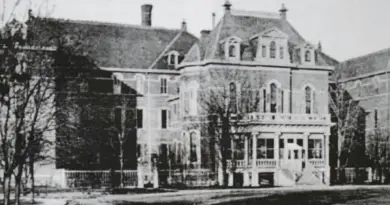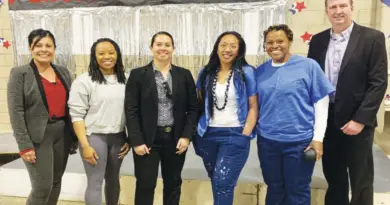Women’s rehabilitation given consideration with early farm concept

The 40-room 1880s-era building at the California Industrial Farm for Women burned down in 1923, effectively shutting down the new institution. (Sonoma County Library.)
Until other institutions were established, women served their sentences at San Quentin State Prison. Early efforts to house females drew criticism in newspapers and with prison inspectors. Meanwhile, beyond the prison walls, the women’s suffrage movement was rapidly gaining steam. These forces converged to create the state’s first reformatory farm for women.
Suffrage leaders pushed for reforms in all aspects of life, including living conditions for incarcerated females.
In 1919, the California legislature agreed, establishing an Industrial Farm for Women. To get the farm operational, legislators provided funding. Though short-lived, the legislation paved the way for future gender-responsive efforts.
Farm-for-women concept given a chance
Legislators provided $150,000 for purchasing at least 200 farmable acres to establish the California Industrial Farm for Women. Nearly two years later, officials chose a site in Sonoma.
“(The trustees) were unanimous in their approval of the site. The farm is known as the old Kate Johnson property in Sonoma,” reported the San Francisco Call, Sept. 14, 1921.
While the farm was 640 acres, far exceeding the required 200, only 30 were suitable for farming.
To focus on rehabilitation, the state opted to go with someone different than previous San Quentin matrons. They selected librarian and suffrage organizer Blanche Morse to run the farm.
Opening the doors
In 1922, the Sonoma farm received its first residents. Much like modern fire camps, the farm wouldn’t accept those convicted of serious violent crimes. Most initial residents came from county jails, but San Quentin could send women serving short terms.
“We are going to give the inmates work to do,” Morse told newspapers at the time. “But, we are not going to apply the institutional idea and make them do it to bells and march-time. Each woman will help around the house in some way.”
By 1922, there were 20 female reformatories across the United States. Their purpose, according to a 1923 article in the Journal of Criminal Law and Criminology, was to “be remedial and reconstructive rather than punitive, working for the speedy return of the offender to community life as a healthy, law-abiding and self-supporting member.”
“No guards, bars (or) cells. Only the great outdoors with gardens to plan, earth to till, chickens to feed, goats to milk and flowers to water,” reported the Humboldt Times, April 1, 1923. “In this atmosphere, 65 women are ‘imprisoned.’ None thinks of escaping. And they are unanimous in declaring they believe the road to reformation has been found.”
Farm-for-women shutter after a year
The Buena Vista Castle was a landmark in Sonoma County, as seen in this undated colorized postcard.
One bonus of the acquisition was a 40-room residence on the grounds. It operated as the administration building and bedrooms for the women.
In March 1923, fire severely damaged the building. Before the devastating blaze, the legislature appropriated only $45,000 for two years of operation. The budget was already far short of what was necessary to implement rehabilitative programs for the 65 women. Now with the building no longer usable, the sum was the final nail in the project’s coffin.
“Damage estimated at $100,000 was done by a fire, (destroying) the main building of the State Industrial Farm for Women and Girls,” reported the Healdsburg Tribune, March 13, 1923. “The building, constructed in 1888, was a Sonoma Valley landmark. It was four stories high, built of wood. … Some of the furnishings were saved, but the famous Buena Vista Castle, which the building has been called for years, is now a heap of smoldering ashes.”
By June 1923, the farm experiment ended. Despite its short life, the project wasn’t a complete wash. The legislation, processes, and viability paved the way for construction of the separate three-story Women’s Department building at San Quentin.
Woman legislator advocates for new institution


While the new building at San Quentin was an improvement over their previous quarters, the state’s only female legislator believed more needed to be done.
Assemblymember Eleanor Miller rewrote the 1919 legislation to create an institution for “the confinement, care, and reformation of women.”
“Eleanor Miller, Pasadena: Authorizing a commission to select a site and prepare for a penal institution for women,” reported the San Pedro Daily News, Jan. 20, 1927.
Passed in 1929, the institution would be overseen by a five-member board of trustees, the majority of them to be women.
In 1931, San Quentin Women’s Department Superintendent Josephine Jackson turned the first spade of dirt at the new site in Tehachapi. The California Institution for Women opened in 1933.



